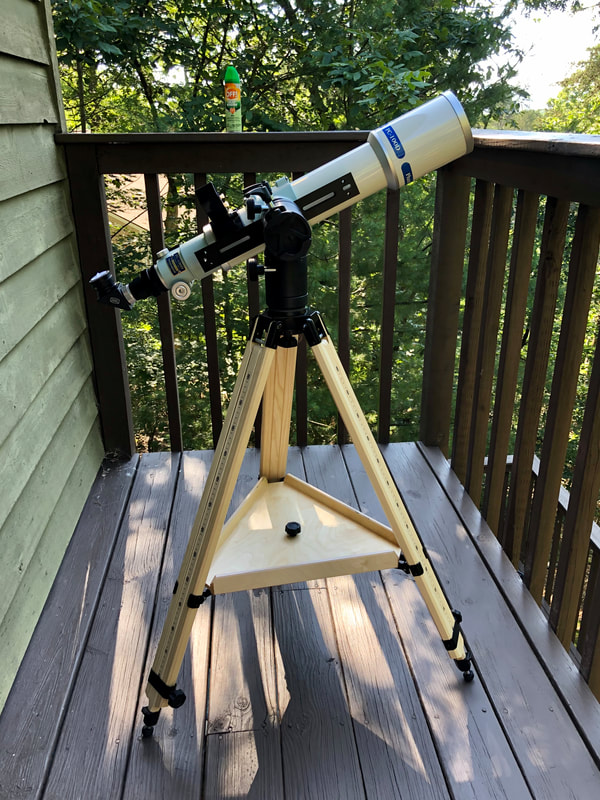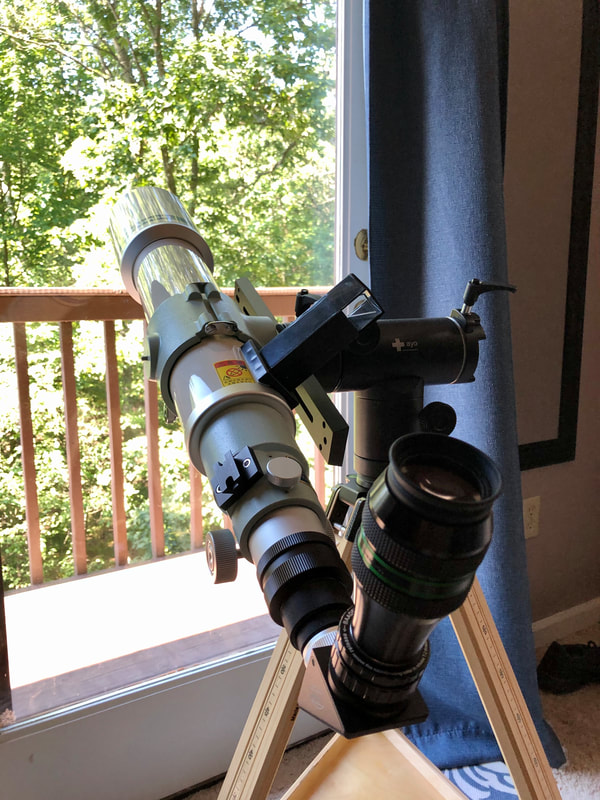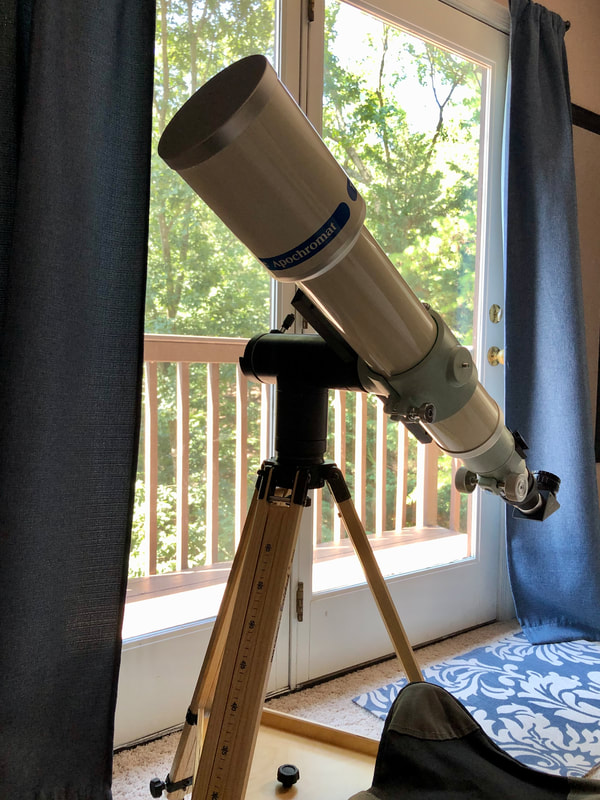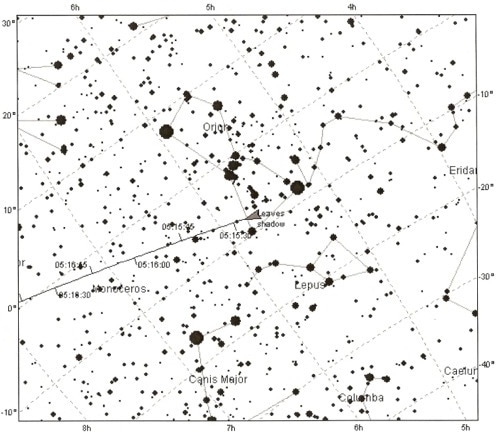|
This weekend, we travelled to the Shenandoah Mountains with our "bubble family" for a much-needed getaway from Washington, DC. It took a little negotiation - even a short trip with kids requires a lot of luggage - but I eventually received authorization to stow a telescope in the trunk. There wasn't much room, so the telescope had to be small, and that left two options: the TV 85 or the Takahashi FC-100DC. I decided I wanted the extra reach of the Takahashi, so I unscrewed its focal extender - shortening and lightening it - and then found a way to make it fit with my lightest tripod. To my delight, our cottage turned out to have two balconies, both isolated from surrounding houses, and was just enough of a clearing in the trees to reveal a part of the night sky. That part, I soon realized, could not have been better placed: it would reveal the Ring Nebula and the Hercules Globular Cluster in the evening, and the Andromeda and Triangulum galaxies in the morning. Even better: the forecast called for clear skies on both nights we were there. What are the odds? On the first night, I stepped directly from my bedroom to the cottage's narrow, second-floor balcony. The air was alive with the squawking of birds and the buzzing of bugs. Luckily I brought plenty of mosquito repellant - although it was hard to forget about the legions of spiders spinning webs just overhead - and wow: what a night sky! Bortle 4, by one classification scheme; yellow or maybe green by another. It was, admittedly, not perfectly dark, but to this city slicker it was nothing short of a revelation. It's been so long since I've seen the Milky Way - but there it was, clearly visible. There were in fact so many stars that it was hard, for a moment, to pick out the constellations! Oh, what I've been missing in DC. To my surprise, Jupiter and Saturn both turned out to be high enough to view from the upstairs balcony. Saturn was beautiful, but I've had better views from the city. Jupiter, by contrast, was so clear and full of contrast - and, lucky me, I had tuned in just on time to see another shadow transit! To think that I'd never seen one before this month. Callisto, it turned out, had just finished traversing the planet, and its shadow was still in the clouds. The shadow seemed a bit more distinct - a bit more clearly round - than it had been on the surface of Jupiter with the APM 140 on the 10th, but I found I couldn't increase the magnification beyond 123x without the view breaking down. To my surprise, I also found that a new Delos 6mm eyepiece presented a clearly better view than my trusty Nagler 3-6mm zoom. Next, it was off to deep space. It has literally been decades since I had a telescope under a reasonably dark sky, and so it was such a pleasure to simply trawl through the Milky Way at low magnification, admiring the knots and clusters of random stars. Every patch of the galaxy, every view, resembled an open cluster from urban skies. Incredible. There are, I realized, deep space objects that look better under dark skies - that is, more of the same - and those that look different. The Ring Nebula, I realized when I finally look that way, mostly looks better. I could easily make out a ring without using averted vision, which I can't do with anything smaller than the APM 140 in DC. Yet I could also make out subtle nebulosity within the ring - a first for me - and the ring didn't look quite as round as it seems in the city. The Hercules Cluster, however, looked completely different: less a fuzzy ball and more an explosion of innumerable stars, textured and complex right down towards the center of the cluster. When I saw textured, I mean it was almost as though someone had sprinkled especially dense clumps of glitter haphazardly over a page already covered with a thinner dusting. An unforgettable sight. On the following night, I decided to sneak out in the morning, this time on the bigger, first-floor balcony so I could see more of the sky. I never have much time with how little my son sleeps, but I hoped to get a good view of two huge deep space objects whose surface brightness is just too low for urban skies - the Andromeda and Triangulum galaxies - before catching a glimpse of Mars.
Andromeda was impressive: a bright, fuzzy nucleus (of course) and a subtle but immense disk, stretching out of view even at 25x. I thought that maybe - just maybe - I could make out a dust lane after around 15 minutes of peering, but that might have been my imagination. At last I tore myself away from the view and started scanning for the Triangulum Galaxy, which I've never managed to spot before. After about 15 minutes I tracked it down, and wow - was it ever subtle. I could make out its pinwheel shape using averted vision, and that was incredibly special to me. At last, Mars became impossible to ignore. Snapping in the 6mm Delos I was treated to an absolutely spectacular view of the planet at 123x, featuring that southern ice cap, of course, surrounded by a ring of remarkably dark dunes, and the unmistakable peninsula of Syrtis Major Planum. I have never had such a detailed view of Syrtis Major, and what timing: the Perseverance rover will soon blast off to land at Jezero crater on the border of the region. To be honest, this view alone exceeded my wildest hopes for the Mars opposition of 2020. Amazing to think that the planet will only seem bigger over the next few months! Yet just as on the previous night, although the view was full of contrast at 123x it broke down when I pushed the magnification much further. I had high hopes for 185x with the Nagler Zoom, but no dice. After a while, it was time to pack up. I was sorely tempted to look at the Pleiades, then just wheeling into view, but I had to be ready in case my son woke up. I couldn't complain, of course; together, both nights were nothing short of unforgettable. I now know: there's nothing better than a fine telescope under dark skies. With regards to the rest of my setup, I was really impressed with a new purchase: that 6mm Delos eyepiece. Beautiful contrast, incredibly easy on the eyes, and a nice field of view. The 30mm TeleVue Plössl was less impressive - actually, it's long been my least favorite eyepiece in my Plössl collection. Stars seem a little stretched out away from the center of the eyepiece; at first, it's like they're not quite in focus, and then, towards the edge of the view, they stretch out into miniature arcs. I think I might need another kind of eyepiece for beautiful wide-field views under dark skies. All in all, a memorable trip, and a welcome relief from these COVID times.
0 Comments
Leave a Reply. |
Archives
March 2024
Categories
All
|






 RSS Feed
RSS Feed